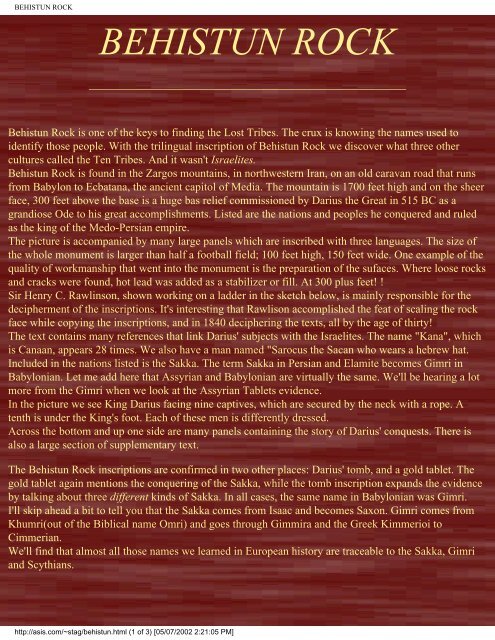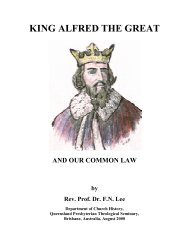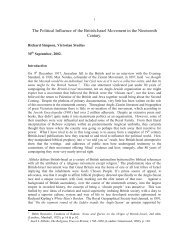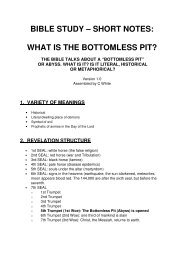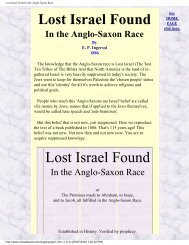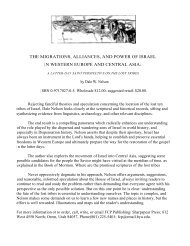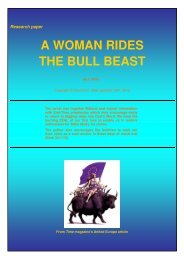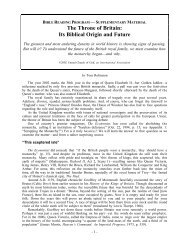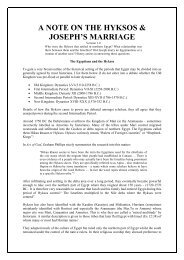Israel's Symbols and Heraldry - Origin of Nations
Israel's Symbols and Heraldry - Origin of Nations
Israel's Symbols and Heraldry - Origin of Nations
- No tags were found...
You also want an ePaper? Increase the reach of your titles
YUMPU automatically turns print PDFs into web optimized ePapers that Google loves.
BEHISTUN ROCKBEHISTUN ROCK________________________________________________________Behistun Rock is one <strong>of</strong> the keys to finding the Lost Tribes. The crux is knowing the names used toidentify those people. With the trilingual inscription <strong>of</strong> Behistun Rock we discover what three othercultures called the Ten Tribes. And it wasn't Israelites.Behistun Rock is found in the Zargos mountains, in northwestern Iran, on an old caravan road that runsfrom Babylon to Ecbatana, the ancient capitol <strong>of</strong> Media. The mountain is 1700 feet high <strong>and</strong> on the sheerface, 300 feet above the base is a huge bas relief commissioned by Darius the Great in 515 BC as agr<strong>and</strong>iose Ode to his great accomplishments. Listed are the nations <strong>and</strong> peoples he conquered <strong>and</strong> ruledas the king <strong>of</strong> the Medo-Persian empire.The picture is accompanied by many large panels which are inscribed with three languages. The size <strong>of</strong>the whole monument is larger than half a football field; 100 feet high, 150 feet wide. One example <strong>of</strong> thequality <strong>of</strong> workmanship that went into the monument is the preparation <strong>of</strong> the sufaces. Where loose rocks<strong>and</strong> cracks were found, hot lead was added as a stabilizer or fill. At 300 plus feet! !Sir Henry C. Rawlinson, shown working on a ladder in the sketch below, is mainly responsible for thedecipherment <strong>of</strong> the inscriptions. It's interesting that Rawlison accomplished the feat <strong>of</strong> scaling the rockface while copying the inscriptions, <strong>and</strong> in 1840 deciphering the texts, all by the age <strong>of</strong> thirty!The text contains many references that link Darius' subjects with the Israelites. The name "Kana", whichis Canaan, appears 28 times. We also have a man named "Sarocus the Sacan who wears a hebrew hat.Included in the nations listed is the Sakka. The term Sakka in Persian <strong>and</strong> Elamite becomes Gimri inBabylonian. Let me add here that Assyrian <strong>and</strong> Babylonian are virtually the same. We'll be hearing a lotmore from the Gimri when we look at the Assyrian Tablets evidence.In the picture we see King Darius facing nine captives, which are secured by the neck with a rope. Atenth is under the King's foot. Each <strong>of</strong> these men is differently dressed.Across the bottom <strong>and</strong> up one side are many panels containing the story <strong>of</strong> Darius' conquests. There isalso a large section <strong>of</strong> supplementary text.The Behistun Rock inscriptions are confirmed in two other places: Darius' tomb, <strong>and</strong> a gold tablet. Thegold tablet again mentions the conquering <strong>of</strong> the Sakka, while the tomb inscription exp<strong>and</strong>s the evidenceby talking about three different kinds <strong>of</strong> Sakka. In all cases, the same name in Babylonian was Gimri.I'll skip ahead a bit to tell you that the Sakka comes from Isaac <strong>and</strong> becomes Saxon. Gimri comes fromKhumri(out <strong>of</strong> the Biblical name Omri) <strong>and</strong> goes through Gimmira <strong>and</strong> the Greek Kimmerioi toCimmerian.We'll find that almost all those names we learned in European history are traceable to the Sakka, Gimri<strong>and</strong> Scythians.http://asis.com/~stag/behistun.html (1 <strong>of</strong> 3) [05/07/2002 2:21:05 PM]


